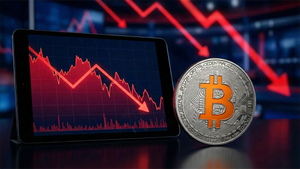
The third quarter of 2025 concluded with a paradox: major U.S. stock indices soaring to unprecedented record highs, propelled by an expanding rally and the tantalizing prospect of Federal Reserve rate cuts, even as the underlying economic currents signaled a material slowdown in the labor market and a stubborn persistence of inflationary pressures. This complex interplay of investor euphoria and economic headwinds has set the stage for a period of both opportunity and profound uncertainty, leaving market participants to navigate a delicate balance.
While the S&P 500, Nasdaq Composite, and Dow Jones Industrial Average all notched new all-time closing highs, with the Dow breaking above 46,000 for the first time, the celebratory mood was tempered by a clear deceleration in job creation and a troubling rise in the unemployment rate. This quarter's performance represents a significant test for the market's resilience, challenging the narrative that a strong stock market can easily shrug off deteriorating economic fundamentals. Investors are now keenly watching to see if the anticipated Fed easing can orchestrate a "soft landing" or if the cracks forming beneath the surface will lead to a more turbulent period ahead.
A Rally Reaches New Peaks, But Not Without Peril
Q3 2025 was defined by a remarkable bullish run in the stock market, extending the gains from a strong first half of the year. The S&P 500 surged, building on its impressive 10.6% climb in Q2, while the Nasdaq Composite (NDAQ) and Dow Jones Industrial Average (DJIA) also posted significant advancements. A key development was the apparent broadening of the rally, moving beyond the concentrated gains of mega-cap technology stocks that had dominated earlier in the year. Investors showed signs of rotating capital into more cyclical sectors such as materials, financials, and energy, suggesting a healthier, more diversified market participation. Small-cap stocks also hinted at a potential rebound, a positive sign for market breadth.
This momentum was largely fueled by the market's conviction that the Federal Reserve would imminently pivot to interest rate cuts. Weakening labor market data, specifically a mere 73,000 nonfarm payrolls added in July, followed by an uptick in the unemployment rate to 4.2% in August and further to 4.3% in September—the highest since October 2021—reinforced expectations. Job openings plummeted to a near decade-low of 7.18 million in July, and U.S. jobless claims reached a four-year high. These figures, combined with largely in-line consumer inflation reports, solidified the market's belief in a September rate cut. Futures markets indicated a high probability of a 25-basis-point reduction, with some speculation even pointing to a more aggressive 50-basis-point cut, as the Fed faced pressure to support a softening economy.
However, beneath this bullish veneer, persistent inflation signals provided a stark counterpoint. The U.S. Consumer Price Index (CPI) rose by 0.4% month-over-month in August, marking the largest increase since January and pushing the annual CPI to 2.9%, up from 2.7% in July. Core CPI, which excludes volatile food and energy prices, remained stubbornly at 3.1%. Rising food prices, particularly for groceries, contributed significantly to the overall inflationary pressure. Moreover, the impact of ongoing trade tariffs remained a considerable concern, with expectations that these policies could temporarily push inflation higher, complicating the Fed's delicate balancing act of supporting growth while taming prices.
Navigating the Shifting Sands: Who Wins and Who Loses?
The complex interplay of a broadening rally, sustained AI demand, a slowing labor market, persistent inflation, and anticipated Federal Reserve rate cuts is creating a bifurcated market, yielding clear winners and potential losers in the post-Q3 2025 landscape.
The Winners' Circle:
The enduring narrative of Artificial Intelligence (AI) continues to supercharge specific technology players. Companies like Broadcom (NASDAQ: AVGO), with its surging AI semiconductor sales up 63% year-over-year, and Meta Platforms (NASDAQ: META), investing billions in generative AI infrastructure, are poised for continued growth. Oracle (NYSE: ORCL) surged on robust cloud outlook driven by AI, while Nebius Group (NBIS) showed explosive growth from AI infrastructure deals. Even Nvidia (NASDAQ: NVDA) and Advanced Micro Devices (NASDAQ: AMD) remain critical players due to their chip technology.
The broadening rally is shifting focus to cyclical sectors. Lower interest rates and potential economic stimulus, particularly from China, are boosting Materials. Copper miners, for instance, are expected to benefit from long-term demand. Financials, despite potential pressure on net interest income from lower rates, could see a rebound in mergers and acquisitions (M&A) and initial public offering (IPO) activity. Energy companies are likely to maintain profitability as crude oil prices remain elevated due to global demand, constrained supply, and geopolitical risks. Furthermore, Industrials could see a lift from falling rates and AI-driven efficiency gains.
Interest-rate sensitive sectors are also set to benefit from Fed cuts. Small-cap stocks, often laden with variable-rate debt, stand to gain significantly from cheaper borrowing. The housing and homebuilding sector is also anticipating a boost, with lower mortgage rates making homeownership more accessible, which Warren Buffett's Berkshire Hathaway (NYSE: BRK.A, BRK.B) seemingly anticipated by acquiring stakes in major homebuilders like D.R. Horton (NYSE: DHI) and Lennar (NYSE: LEN) in Q2.
The Losing Edge:
The Consumer Discretionary sector faces significant headwinds. A slowing labor market, characterized by decelerating job growth and rising unemployment, coupled with persistent inflation, is eroding consumer purchasing power. This is expected to lead to a slowdown in consumer spending, impacting companies reliant on non-essential goods and services. Lower- and middle-income households are particularly vulnerable to these pressures.
Companies with high debt burdens, especially those struggling to cover interest payments with operating profit (often dubbed "zombie companies"), are increasingly at risk. While rate cuts offer some relief, the overall interest rate environment, combined with inflation, still poses a substantial challenge. Triggers such as economic slowdowns or shifts in private credit markets could lead to mass failures among these highly leveraged entities.
While AI-driven tech remains strong, select overvalued technology stocks might see a correction as capital rotates into other sectors. The market's elevated price-to-earnings (P/E) ratio for the S&P 500, above its 10-year average, suggests that some investments may be due for a re-evaluation as investors seek better value.
Industry Shifts and Broader Economic Fault Lines
The Q3 2025 market dynamics—record highs, a broadening rally, a softening labor market, stubborn inflation, and anticipated Fed rate cuts—are not isolated incidents but rather critical indicators of profound shifts in the broader economic and industrial landscape. This complex environment necessitates adaptation and poses both opportunities and systemic risks.
The broadening rally, while a positive sign of market health, suggests a re-evaluation of valuation across sectors. Industries that have historically lagged, such as older manufacturing, traditional financials, and utilities, could see renewed investment. This shift may spur increased capital expenditure in these sectors, promoting modernization and efficiency, particularly if combined with AI adoption. However, it also implies increased competition for capital for previously favored tech giants, potentially slowing their hyper-growth trajectories if the market's focus diversifies.
The slowing labor market has far-reaching ripple effects. Beyond its immediate impact on consumer spending, it could lead to reduced demand for business services, tempering growth for consulting and IT firms. Industries reliant on a robust workforce, such as construction and logistics, may face project delays and increased labor costs despite rising unemployment, if skilled labor shortages persist. This trend could accelerate automation efforts in industries like manufacturing and even healthcare, as companies seek to mitigate labor dependencies. Furthermore, the downward revisions in historical job creation paint a more concerning picture of underlying economic strength, indicating that sectors like leisure and hospitality, information technology, and professional services were weaker than initially perceived.
Persistent inflation, exacerbated by factors like rising food prices and trade tariffs, creates a challenging operating environment. Industries with high input costs, like manufacturing, transportation, and agriculture, will continue to struggle with margin compression unless they can effectively pass costs to consumers or find efficiencies. The service sector, from healthcare to auto repair, also faces significant price pressures. Tariffs, in particular, represent a policy decision with direct inflationary consequences, essentially acting as a tax on consumers and businesses. This trend encourages a re-evaluation of global supply chains, potentially accelerating "onshoring" or "friendshoring" strategies to reduce geopolitical and cost-related risks, impacting global trade partners and logistics industries.
Historically, this confluence of factors draws parallels to periods of economic transition. Broadening rallies have sometimes preceded more stable growth phases, but also, in cases of overheating, have marked tops before corrections. The scenario of a central bank cutting rates amid persistent inflation and a softening labor market echoes the challenging environment of the 1970s, raising the specter of "stagflation." In such a scenario, traditional monetary policy tools become less effective, as measures to curb inflation can stifle growth, and vice versa. Regulatory bodies, particularly the Federal Reserve, are treading a policy tightrope. Their actions on interest rates will have profound implications for corporate borrowing, consumer credit, and asset valuations across the board. The credibility of the Fed's dual mandate, price stability and maximum employment, is under intense scrutiny. Meanwhile, ongoing debates around trade tariffs signal a potential shift towards more protectionist policies, which could fragment global alliances and reshape international commerce.
The Road Ahead: Navigating Uncertainty and Opportunity
As Q3 2025 recedes, the market and economy face a landscape defined by critical turning points and divergent paths. Both short-term adjustments and long-term strategic pivots will be essential for companies and investors.
In the short-term (late 2025 - early 2026), continued market volatility is expected, with the rally potentially narrowing again or experiencing periodic pullbacks. The labor market will likely continue softening, with job growth remaining modest and unemployment gradually climbing. Inflation is projected to remain stubbornly above the Fed's 2% target, potentially averaging around 3.5% in 2025, largely due to tariff-related price pressures. The Federal Reserve is highly anticipated to enact further rate cuts beyond September's initial move, likely two more before year-end, and additional easing into 2026. However, these might be "hawkish cuts," signaling a cautious approach to avoid reigniting inflation. Companies will need to leverage an easier financing environment for strategic mergers and acquisitions and prioritize innovation and product diversification. Cost management and resilient supply chains are paramount in an inflationary environment, especially for tariff-sensitive industries.
Looking long-term (2026 and beyond), a sustained downward trajectory for interest rates is projected, with the federal funds rate potentially stabilizing in a range of 2.25% to 3.50% by 2026-2027. Global economic growth is expected to remain subdued, around 2.8-2.9% in 2026, with a "soft landing" or an "economic slowdown" being the most likely scenario for the U.S. rather than a deep recession. Productivity advancements, particularly from AI, could surprise on the upside, accelerating GDP growth. Companies must focus on retaining talent through flexible work, leveraging AI for efficiency, and upskilling existing staff in a tighter labor market. Emerging markets (EMs) present significant opportunities, projected to outgrow advanced economies with an average GDP growth of 3.7% in 2025, driven by structural reforms and resilient domestic demand, especially in regions like India, ASEAN, and the Middle East. However, EMs also face challenges from U.S. trade policy uncertainty and persistent internal inflation.
Potential scenarios for the economy and market vary:
- Base Case: Soft Landing with Gradual Adjustment: Inflation slowly trends down to target, the Fed enacts measured cuts, the labor market softens without collapsing, leading to slower but positive GDP growth and continued corporate earnings.
- Alternative 1: Stagflation-Lite: Inflation proves more persistent, potentially re-accelerating due to tariffs. The Fed is forced to keep rates higher for longer or struggles to balance its mandates, leading to slower GDP growth, higher unemployment, and increased market volatility.
- Alternative 2: Faster Disinflation and Dovish Fed: Inflation moderates more quickly, allowing the Fed to cut rates more aggressively. The labor market stabilizes, leading to stronger GDP growth and a more sustained bull market.
Overall, the period post-Q3 2025 will require vigilance and adaptability from companies and investors. The interplay of a broadening but sometimes narrow market rally, a softening labor market, stubbornly high inflation, and a cautiously easing Fed will define the economic and market trajectory, presenting a complex but navigable landscape.
Conclusion: A Market at a Crossroads
Q3 2025 will be remembered as a pivotal quarter, one where the stock market defied gravity to reach new pinnacles, fueled by the hope of central bank intervention, even as fundamental economic indicators flashed cautionary signs. The record highs and the broadening of the rally beyond the dominant tech sector offered a semblance of robust market health. Yet, the simultaneous weakening of the labor market, persistent inflationary pressures, and the complexities introduced by trade tariffs underscore a market grappling with profound underlying fragilities.
Moving forward, investors face a finely balanced equation. The Federal Reserve's anticipated rate cuts are a critical variable, holding the potential to either gently guide the economy to a soft landing or, if misjudged, to exacerbate inflationary pressures or fail to prevent a deeper downturn. The market's resilience will be tested by the ongoing push-pull between economic moderation and the stimulus of cheaper capital. Companies that exhibit agility in adapting their supply chains, managing costs, and strategically investing in innovation will be best positioned to navigate this dynamic environment.
The key takeaway is vigilance. Investors should watch for the actual pace and depth of Fed rate cuts, monitor inflation's trajectory (especially beyond headline numbers), and scrutinize labor market data for signs of stabilization or further deterioration. The interplay of these forces will determine whether the post-Q3 2025 period ushers in a new era of diversified growth or a prolonged period of economic and market uncertainty. The market stands at a crossroads, and the path it takes will have lasting implications for all stakeholders.





